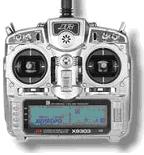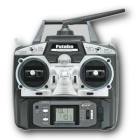Spread spectrum radio control equipment on the 2.4GHz band has now been around for
well over a year and it's hard to find a single system that hasn't had at least
a few teething problems. It's only natural that such a dramatic shift in technology
will result in unforseen issues raising their heads and no manufacturer is immune
to this. Perhaps what is more important than the fact they've all had problems is
the way that each manufacturer has addressed those problems and the amount of support
they've offered to their customers. Here are a list of the known issues to date
and the manufacturers' responses. You can draw your own conclusions as to what's
good and what's not.
Spectrum/JR

One of the very first to offer a 2.4GHz system and now the most popular brand, having
many times more systems in use than any other manufacturer, it's only natural that
the problems encountered by users of this equipment would be more widely known.
The very first systems suffered from a very slow re-link time (as much as 10 seconds
or more) in the event that the receiver rebooted due to low-voltage or a voltage
spike. This problem was exacerbated by the fact that the systems were shipped with
just a 4-cell (4.8V) receiver pack which could easily be pulled down to 4V or less
by several servos operating simultaneously. That's a voltage low enough to cause
the receiver to reboot, effectively causing all control to be lost. The problem
was also made worse by the number of people flying electric models with inadequate
BECs that would also allow the receiver voltage to drop low enough to cause a reboot.
To their credit, the manufacturer has quickly addressed the problem and now there
are several "fixes". Firstly, the software in the receiver has been updated to allow
a faster relink time (often under 1 second) in the event that the receiver reboots.
Secondly, a "supercapacitor" is available that will help reduce the effect of momentary
voltage spikes or drops -- acting like a very tiny backup battery. Thirdly, users
are now encouraged to use a 5-cell (6V) receiver pack so as to allow far more "headroom"
between the reboot voltage and that delivered by the battery. The next issue affecting
JR/Spectrum gear was that of poor switch wiring on the AR9100 receiver. A stray
wire could cause these "smart" switches to fail. This was quickly addressed by both
users and the manufacturer. Most recently, users of the X9303 transmitter have found
that internal wiring can have its insulation worn away by contact with an internal
regulator device. Once again the manufacturer has been quick to post this advisory
and offer a free repair for anyone whose gear may be affected.
Futaba FASST

The first problem with the Futaba FASST systems was the zero GUID issue which saw
some sets losing a small but critical part of their memory which resulted in multiple
systems interacting in a rather unpleasant way. In effect, two systems that suffered
this problem could end up shooting each other down. A more recent, and potentially
just as critical issue has been discovered by those using the FASST system in the
heat of summer. A growing number of crashes and near-misses have been attributed
to the effect of high ambient temperatures on the FASST receivers. Independent tests
(conducted by FASST owners) indicate that once these receivers reach or exceed a
temperature as low as 120 deg F, they simply shut down and stop working. When the
temperature is lowered, normal operation is restored. Once again, the US distributor
for Futaba remains non-committal and apparently unwilling to even acknowledge the
existence of the problem. There is therefore, no fix at this stage and commonsense
suggests that anyone flying FASST in high temperatures should take great care to
ensure their models are kept out of the sun when not being flown. Some FASST users
have even taken to fitting onboard fans to keep their receivers cool and thus reduce
the chances of the heat problem affecting them. JR/Spektrum have taken advantage
of this problem with FASST by launching an advertising campaign that promotes the
fact their receivers work quite happily at temperatures up to 300 degrees F. Talk
about rubbing salt in the wound!